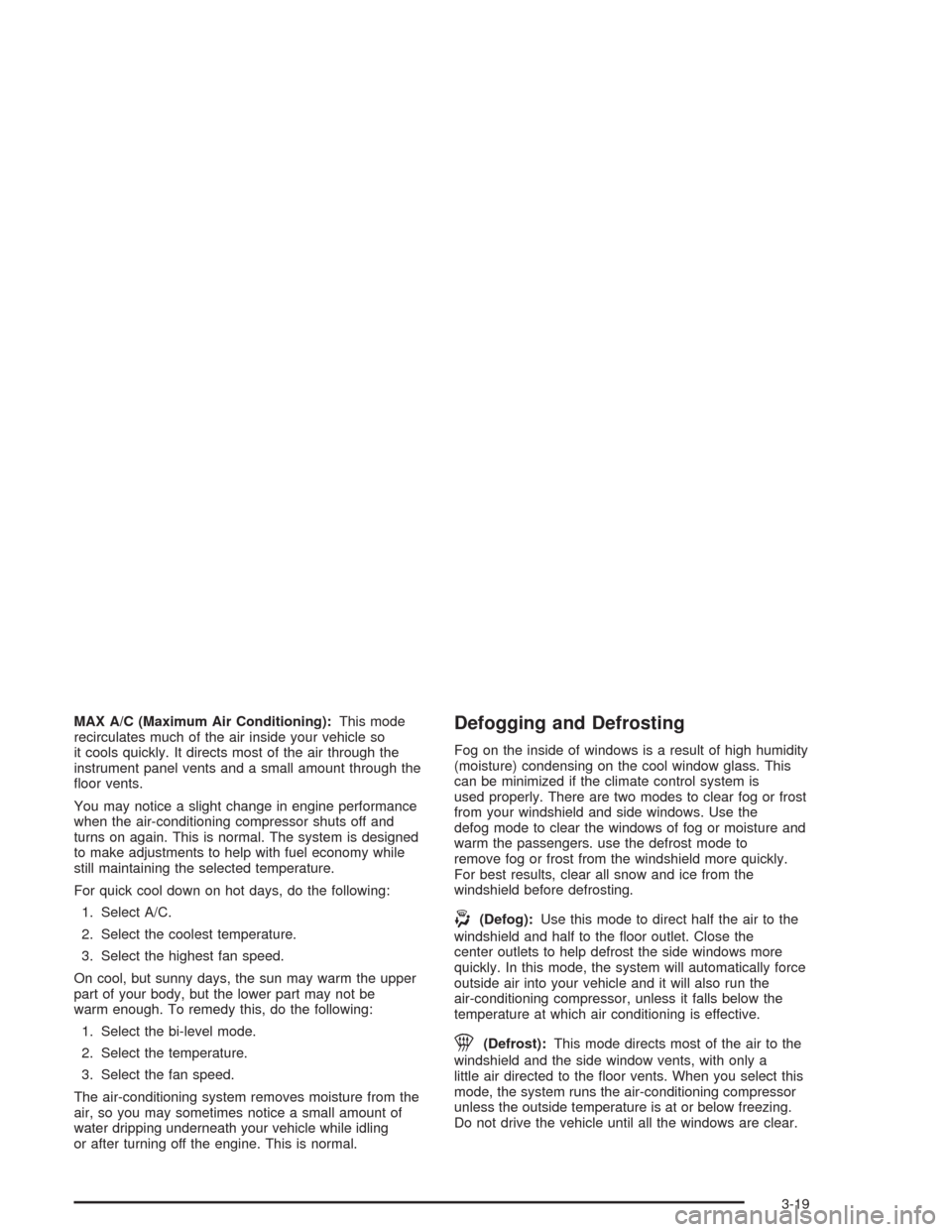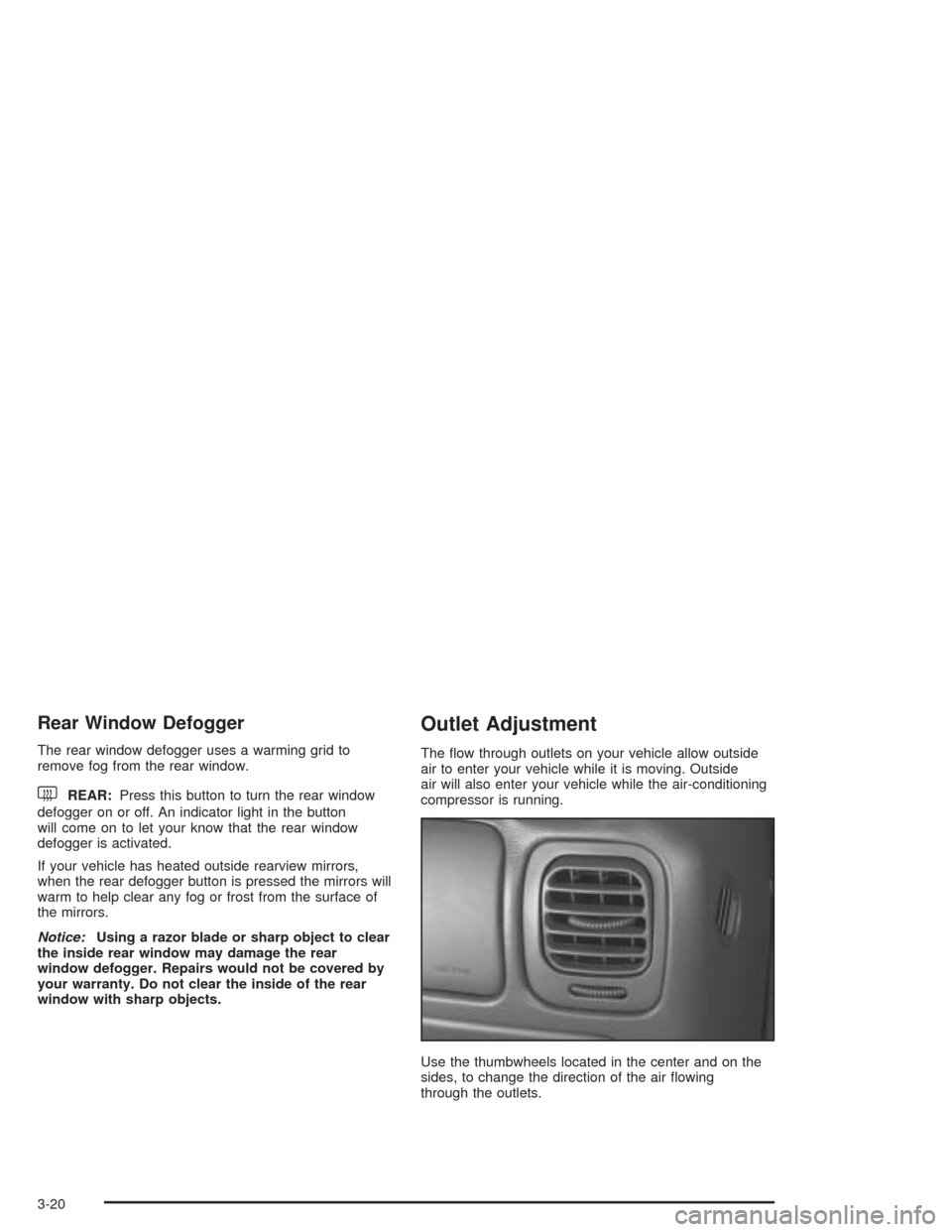2004 CHEVROLET BLAZER fog light
[x] Cancel search: fog lightPage 133 of 446

A. Air Vents. SeeOutlet Adjustment on page 3-20for
more information.
B. Turn Signal/Multifunction Lever. SeeTurn
Signal/Multifunction Lever on page 3-5for more
information.
C. Instrument Panel Cluster. SeeInstrument Panel
Cluster on page 3-22for more information.
D. Transfer Case Button (If Equipped). See “Transfer
Case” underFour-Wheel Drive on page 5-48
for more information.
E. Exterior Lamps Control. SeeExterior Lamps on
page 3-12for more information.
F. Fog Lamp Button (If Equipped). See “Fog Lamps”
underExterior Lamps on page 3-12for more
information.
G. Brake Release. SeeParking Brake on page 2-35for
more information.
H. Horn. SeeHorn on page 3-5for more information.I. Rear Window Washer/Wiper. SeeWindshield Wiper
Blade Replacement on page 5-55for more
information.
J. Rear Tailgate Release. See “Rear Tailgate Release”
underRear Window on page 2-13for more
information.
K. Ashtray (If Equipped). SeeAshtrays and Cigarette
Lighter on page 3-17for more information.
L. Climate Control System. SeeClimate Control
System on page 3-17for more information.
M. Rear Window Defogger. See “Rear Window
Defogger” underClimate Control System on
page 3-17for more information.
N. Audio System. SeeAudio System(s) on page 3-37
for more information.
O. Glove Box. SeeGlove Box on page 2-49for more
information.
3-3
Page 145 of 446

Fog Lamps
Your vehicle may be equipped with fog lamps. Use your
fog lamps for better vision in foggy or misty conditions.
Your parking lamps or headlamps must be on for
your fog lamps to work.
The fog lamp button is located on the instrument panel
near the lamp control.
Press the button to turn the fog lamps on. Press the
button again to turn them off. A light will glow in
the button when the fog lamps are on.
Fog lamps will go off whenever your high-beam
headlamps come on. When the high-beams go off, the
fog lamps will come on again.
Interior Lamps
Instrumental Panel Brightness
The thumbwheel for this feature is located on the
driver’s side of the instrument panel next to the exterior
lamps control.
Turn the thumbwheel up to make your instrument panel
lights brighter. Turn the thumbwheel all the way up to
turn on the interior lamps. To dim the instrument
panel lights, turn the thumbwheel down.
Entry Lighting
Your vehicle is equipped with an illuminated entry
feature.
When a door is opened, the dome lamps will come on if
the DOME OVERRIDE button is in the out position.
When the doors are closed, the lamps will stay on for a
short period of time and will turn off automatically. If
you use your keyless entry transmitter, if equipped, to
unlock your vehicle, the interior lamps will come on for a
short time whether or not the DOME OVERRIDE
button is in the out position.
3-15
Page 149 of 446

MAX A/C (Maximum Air Conditioning):This mode
recirculates much of the air inside your vehicle so
it cools quickly. It directs most of the air through the
instrument panel vents and a small amount through the
�oor vents.
You may notice a slight change in engine performance
when the air-conditioning compressor shuts off and
turns on again. This is normal. The system is designed
to make adjustments to help with fuel economy while
still maintaining the selected temperature.
For quick cool down on hot days, do the following:
1. Select A/C.
2. Select the coolest temperature.
3. Select the highest fan speed.
On cool, but sunny days, the sun may warm the upper
part of your body, but the lower part may not be
warm enough. To remedy this, do the following:
1. Select the bi-level mode.
2. Select the temperature.
3. Select the fan speed.
The air-conditioning system removes moisture from the
air, so you may sometimes notice a small amount of
water dripping underneath your vehicle while idling
or after turning off the engine. This is normal.Defogging and Defrosting
Fog on the inside of windows is a result of high humidity
(moisture) condensing on the cool window glass. This
can be minimized if the climate control system is
used properly. There are two modes to clear fog or frost
from your windshield and side windows. Use the
defog mode to clear the windows of fog or moisture and
warm the passengers. use the defrost mode to
remove fog or frost from the windshield more quickly.
For best results, clear all snow and ice from the
windshield before defrosting.
-(Defog):Use this mode to direct half the air to the
windshield and half to the �oor outlet. Close the
center outlets to help defrost the side windows more
quickly. In this mode, the system will automatically force
outside air into your vehicle and it will also run the
air-conditioning compressor, unless it falls below the
temperature at which air conditioning is effective.
1(Defrost):This mode directs most of the air to the
windshield and the side window vents, with only a
little air directed to the �oor vents. When you select this
mode, the system runs the air-conditioning compressor
unless the outside temperature is at or below freezing.
Do not drive the vehicle until all the windows are clear.
3-19
Page 150 of 446

Rear Window Defogger
The rear window defogger uses a warming grid to
remove fog from the rear window.
will come on to let your know that the rear window
defogger is activated.
If your vehicle has heated outside rearview mirrors,
when the rear defogger button is pressed the mirrors will
warm to help clear any fog or frost from the surface of
the mirrors.
Notice:Using a razor blade or sharp object to clear
the inside rear window may damage the rear
window defogger. Repairs would not be covered by
your warranty. Do not clear the inside of the rear
window with sharp objects.
Outlet Adjustment
The �ow through outlets on your vehicle allow outside
air to enter your vehicle while it is moving. Outside
air will also enter your vehicle while the air-conditioning
compressor is running.
Use the thumbwheels located in the center and on the
sides, to change the direction of the air �owing
through the outlets.
3-20
Page 379 of 446

Fuse Usage
IGN B Column Feed,Ignition 2, 3, 4
STARTER Starter
RAP Retained Accessory Power
LD LEV Not Used
OXYSEN Oxygen Sensor
IGN E Engine
MIR/LKS Mirrors, Door Locks
FOG LP Fog Lamps
IGN A Starting and Charging Ignition 1
STUD #2 Accessory Feeds, Electric Brake
PARKLP Parking Lamps
LR PRK Left Rear Parking Lamps
LIFTGLASS Liftglass
IGN CStarter Solenoid, Fuel Pump,
PRNDL
HTDSEAT Heated Seat
HVACHeating,Ventilation, Air Cooling
System
TRCHMSLTrailer Center High Mount
Stop Light
RRDFOG Rear Defogger
TBC Truck Body Computer
CRANK Clutch Switch, NSBU Switch
CHMSL Center High Mounted StoplampFuse Usage
HAZLP Hazard Lamps
VECHMSLVehicle Center High-Mounted
Stop Lamp
RR DEFOG Rear Defogger
HTDMIR Heated Mirror
ATC Transfer Case (Four-Wheel Drive)
STOPLP Stop Lamps
RR W/W Rear Window Wiper
Capacities and Speci�cations
Engine Speci�cations
Engine VORTEC™ 4300
VIN Code X
Spark Plug Gap 0.060 inches (1.52 mm)
Firing Order 1–6–5–4–3–2
Wheels and Tires
Wheel Nut Torque 100 lb-ft (140 N·m)
Tire PressureSee the Certi�cation/Tire
label. See “Loading Your
Vehicle” in the Index.
5-103
Page 436 of 446

Finding a Station....................3-39, 3-42, 3-50, 3-61
Finish Care....................................................5-93
Finish Damage...............................................5-95
Five-Speed....................................................2-26
Fixed Mast Antenna........................................3-74
Flash-to-Pass Feature....................................... 3-7
Flat Tire........................................................5-75
Flat Tire, Changing.........................................5-76
Fluid
Automatic Transmission................................5-19
Manual Transmission....................................5-22
Power Steering...........................................5-36
Windshield Washer......................................5-38
FM ...............................................................3-72
Fog Lamps....................................................3-15
Following Distance..........................................4-67
Footnotes................................................6-7, 6-18
Four Door Models...........................1-26, 1-28, 1-51
Four-Wheel Drive....................................2-28, 5-48
Front Axle......................................................5-49
Front Map Lamps...........................................3-16
Front Reading Lamps......................................3-16
Front Storage Area.........................................2-56
Fuel............................................................... 5-4
Additives...................................................... 5-6
California Fuel.............................................. 5-5
Filling a Portable Fuel Container..................... 5-9
Filling Your Tank........................................... 5-7
Fuels in Foreign Countries.............................. 5-6Fuel (cont.)
Gage.........................................................3-36
Gasoline Octane........................................... 5-4
Gasoline Speci�cations.................................. 5-5
Low Warning Light.......................................3-36
System Inspection.......................................6-31
Fuses
Fuses and Circuit Breakers...........................5-99
Windshield Wiper.........................................5-98
G
Gage
Check Gages Warning Light..........................3-35
Engine Coolant Temperature.........................3-29
Fuel..........................................................3-36
Oil Pressure...............................................3-33
Speedometer..............................................3-24
Tachometer.................................................3-24
Voltmeter Gage...........................................3-26
Garage Door Opener.......................................2-44
Garment Hooks..............................................2-57
Gasoline
Octane........................................................ 5-4
Speci�cations............................................... 5-5
Gate Ajar Light...............................................3-35
Gate Operator and Canadian Programming........2-48
Getting Familiar with Off-Road Driving................4-17
6